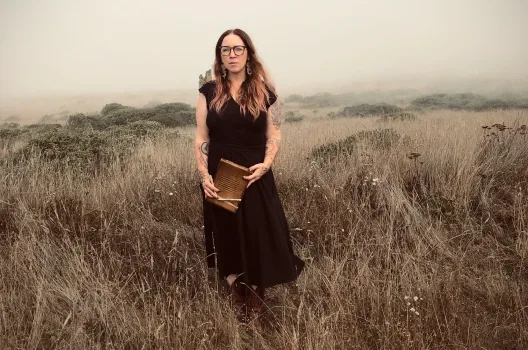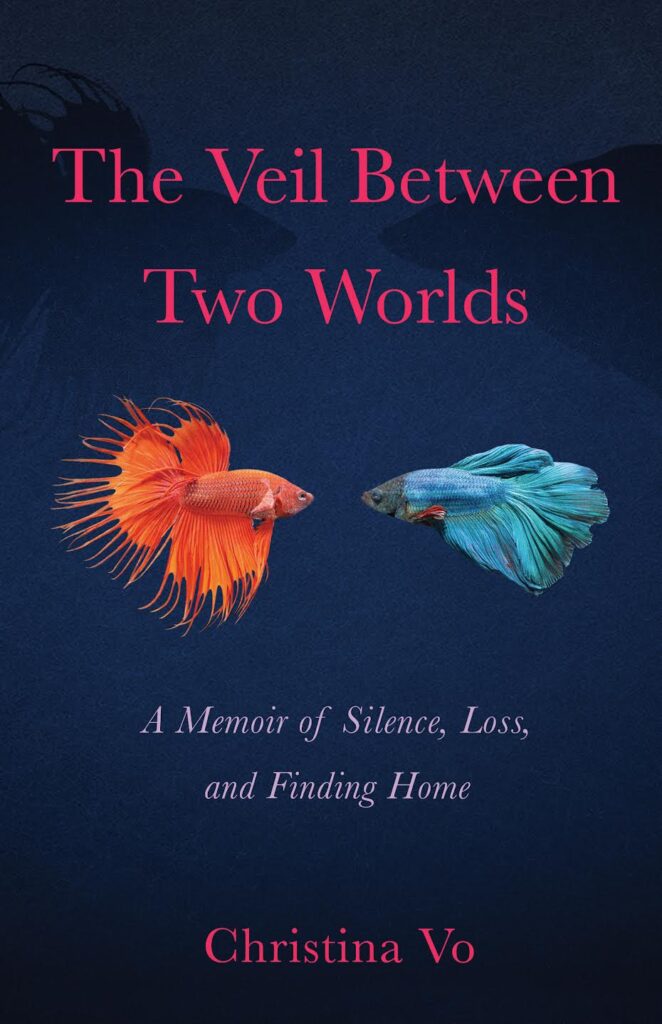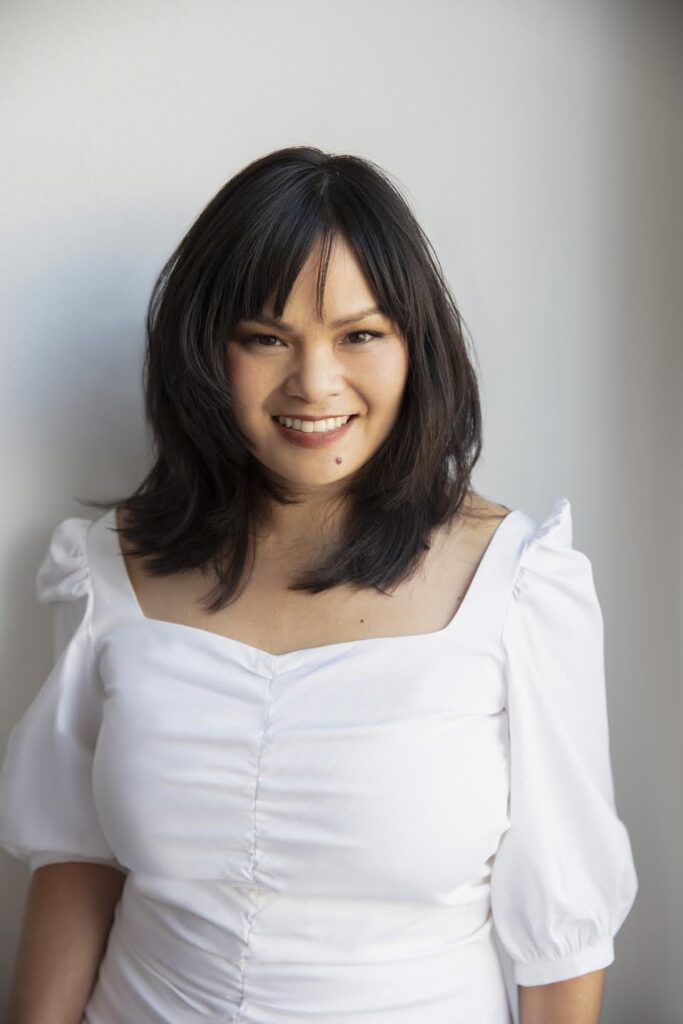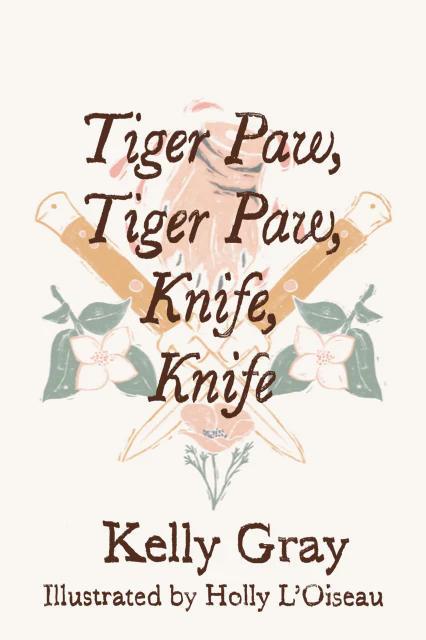
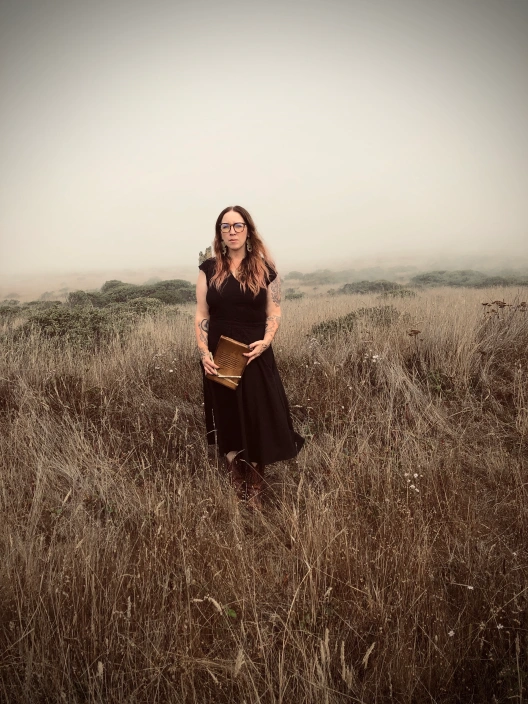
Congratulations to Kelly Gray for her upcoming memoir Tiger Paw, Tiger Paw, Knife, Knife, published by Quarter Press. Filled with beautiful prose, each story twists and recurs back on the stories told before it. Gray expertly blends themes of love and abuse, birth and rebirth, and death and life. Her words are complimented by Holly L’Oiseau’s stunning illustrations.
Some of the works within Tiger Paw, Tiger Paw, Knife, Knife spark like tiny flashes of brilliance—as in “The History of Flowers that Eat Meat.” Only a page long, this surreal piece depicts a strange sort of growing up. In the short space, a single word holds dozens of meanings: “I am bog blossom pretty, which is to say, not at all. My skin is fly paper sticky and boys think it’s honey.”
Other, longer works burn more slowly but are no less rewarding. In “Serenade Switchblade,” Gray artfully describes a relationship that descends from teenage infatuation to terrible violence. The last, powerful sentences of the piece grip the reader and won’t let go: “It tasted like the moment before you scream because I am prettier dead than any poem you’ll ever write.”
Kelly Gray (she/her/hers) lives in Northern California on unceded Coast Miwok and Kashaya Pomo land. She writes about what she knows or is trying to know; parenting, eco-grief, mental health, dead things, monsters, prophetic animals, relationships to self and others, and rural life. To learn more, visit her website.
To purchase Tiger Paw, Tiger Paw, Knife, Knife, go here.
We’re also very excited to share an interview that dives deeper into Kelly Gray’s book. This interview was conducted via email by our Blog Editor, Brennie Shoup.
Brennie Shoup: Tiger Paw, Tiger Paw, Knife, Knife is described as a “folk-told” memoir. Could you discuss what inspired you to write a memoir in such an unusual way?
Kelly Gray: I have always found genres to be containers that don’t fit my writing. The separation of fiction, poetry, creative nonfiction (which can hold memoir) seems unnecessarily clinical to me. I hope to have a level of fluidity within my work which represents my beliefs around connection in the world. I want to share my stories while being real about the people in my life. When appropriate, I want to honor and protect other people’s experiences but still be able to say these are my origin stories, this is where I come from.
When I say folk-told, that is a nod towards all the storytellers before and after me, as well as the characters within the stories. Folk-told is my acknowledgment that we have these experiences together and I just happen to be the writer this time. For instance, in Sylvia, I was drawing from my work as an abortion and birth attendant watching families grapple with loss and the logistics of death, but the character Sylvia was coming up through me and my own witnessing of an infant’s death and my desires to be held more fully by my community. The life of Sylvia and William come from a careful folding in of years of experience and influence, told through the lens of fiction, because that is how we get to the fox, which is probably the truest-to-my heart part of that story.
BS: Your memoir blends humanity with nature, often through surrealism. Could you talk about why you chose to do this?
KG: It’s less of a choice and more of an acknowledgment of how I absorb the world. Specific images will take up in my body as I am move through the world. My writing process is often an act of personal translation, from imagery to sentences to stories. My first drafts are my attempts to understand myself—I am learning as I go. The act of revision is when I begin to mold what I’ve learned and through sound and syntax and sometimes trajectories, I get to relate it to others. It comes out as surrealism, or speculative, or fantastical. But I think it’s just where my brain is blooming pictures.
As far as the nature aspect, it may reveal as much about the reader’s place in the world as mine. It’s what I am looking at every day. If you don’t see it as much, maybe it stands out more in the stories. As I write this, I am looking at a wall of trees, and the creek below my house is so loud it sounds like a storm. I can see a raven on a tree and above that, in the sky, a kettle of turkey vultures are out warming their wings after weeks of ravaging rain. This is just what I see, and as a naturalist, I have learned a langue that allows me to name what I am paying attention to.
BS: The title itself—Tiger Paw, Tiger Paw, Knife, Knife—is eye-catching in its specificity, especially with the repetitions. Why did you choose this title for your memoir?
KG: I wasn’t intending to do this initially, but tiger paws and knives come up in several stories, starting with Frank the tiger cutting off his own paw in the face of domesticity. That is the overarching theme of the book: how much we are willing to cut out to find our more authentic selves? For me, apparently, it needs frequent repeating in my life. The titles ends up
being a mantra of sorts.
BS: Many of your smaller prose pieces deal with both love and abuse, as in “Coyote Story” and “Switchblade Serenade.” Could you discuss how you balance these themes as a writer, particularly in such short spaces?
KG: This book was always more about the impetus for change as opposed to the change itself. In “Switchblade Serenade,” the main character had to die and be dead for some time before she realized she had been tricked into foregoing love by little affections. Of course, the reader sees it. The reader is like, “Sweetie, this is a horrible situation for you, you should bounce.” But she doesn’t—she stays. I think that is relatable because many of us are in a collective holding pattern with abuse right now.
Abuse is complicated because it’s often shrouded in kernels of what we need for survival. An abuser can make you feel good or can provide you essentials like shelter or income. You may not think you can provide these things for yourself, and sometimes that is true. For instance, this is why we must look at the housing crisis when we are talking about domestic violence, or why union busting tactics often include things dispensing really great benefits in the face of a mounting campaign. My writing is as much about the misconceptions of personalized love as it is about systemic abuse, because what I am really talking about is getting rid of what we don’t need, and that is hard to do when it feels so good, or is legitimately something that you need, such as a parent.
Writing is always an act of self-love because as writers, we are saying I am worth listening to. At the beginning of any piece, no matter how small the work, we have an invisible contract with our reader that says I am taking up this space and that requires some amount of self-love. From there, we can explore all the places love doesn’t exist, and I think the reader is able to go along for the ride because it is story, as opposed to living it or witnessing it in real time. The readers understands that at some invisible yet foundational level, love is beaming up through the work. Love makes writing about abuse palatable whereas the craft makes it engaging.
